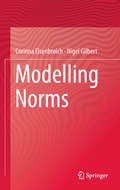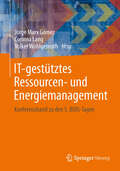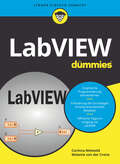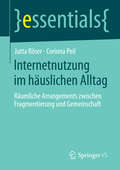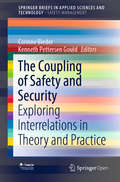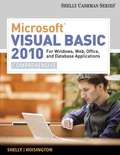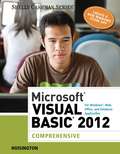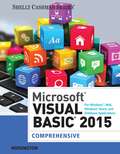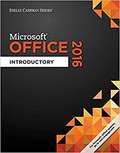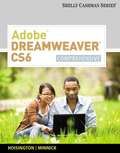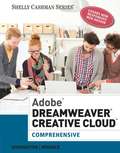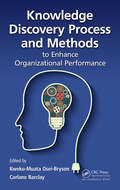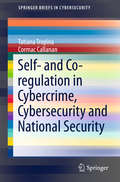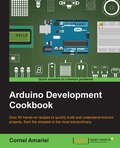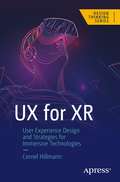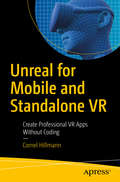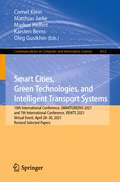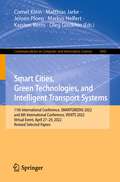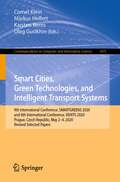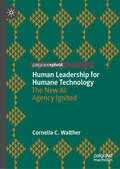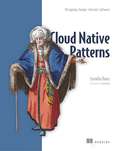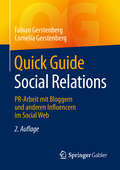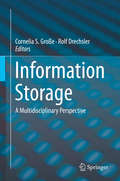- Table View
- List View
Modelling Norms
by Nigel Gilbert Corinna ElsenbroichThe book focusses on questions of individual and collective action, the emergence and dynamics of social norms and the feedback between individual behaviour and social phenomena. It discusses traditional modelling approaches to social norms and shows the usefulness of agent-based modelling for the study of these micro-macro interactions. Existing agent-based models of social norms are discussed and it is shown that so far too much priority has been given to parsimonious models and questions of the emergence of norms, with many aspects of social norms, such as norm-change, not being modelled. Juvenile delinquency, group radicalisation and moral decision making are used as case studies for agent-based models of collective action extending existing models by providing an embedding into social networks, social influence via argumentation and a causal action theory of moral decision making. The major contribution of the book is to highlight the multifaceted nature of the dynamics of social norms, consisting not only of emergence, and the importance of embedding of agent-based models into existing theory.
IT-gestütztes Ressourcen- und Energiemanagement: Konferenzband zu den 5. BUIS-Tagen
by Jorge Marx Gómez Volker Wohlgemuth Corinna LangIn diesem Tagungsband zu den 5. BUIS-Tagen (15. Tagung der Fachgruppe Betriebliche Umweltinformationssysteme der Gesellschaft für Informatik e.V.) werden aktuelle Themen des IT-gestützte Ressourcen- und Energiemanagements präsentiert mit dem Fokus auf: Green IT und Energieeffizienz, Stoffstrommanagement, Green Production, Green Logistics, Nachhaltigkeitsmanagement und Kommunikation, Green Software sowie Materialeffizienz und Recycling. In der "Students Corner" präsentieren Studierende eigene Lösungsansätze aus Projekten und Abschlußarbeiten.
LabVIEW für Dummies (Für Dummies)
by Corinna Meiwald Melanie von der CroneGanz unverhofft müssen Sie sich mit LabVIEW beschäftigen? Dieses Buch hilft Ihnen dabei sich in diesem grafischen Programmiersystem zurechtzufinden. Die Autorinnen erklären Ihnen die Grundlagen von grafischer Programmierung und erläutern was Virtuelle Instrumente (VIs) sind. Sie führen Sie in die Arbeit in Projekten mit LabVIEW ein, zeigen Ihnen was Sie bei der Fehlersuche beachten sollten, wie Sie Datentypen und Datenstrukturen verwenden und vieles mehr. Dabei kommt auch das klassische Programmieren nicht zu kurz und so werden Sie sich schneller als Sie denken in LabVIEW zurechtfinden.
Internetnutzung im häuslichen Alltag: Räumliche Arrangements zwischen Fragmentierung und Gemeinschaft (essentials)
by Jutta Röser Corinna PeilDer Beitrag präsentiert aktuelle Befunde zur Internetnutzung im häuslichen Alltag. Die Autorinnen nehmen zunächst eine Systematisierung alltagsbezogener Rezeptionsforschung der Cultural Studies vor und führen den Domestizierungsansatz ein. Auf Basis ethnografisch orientierter Haushaltsstudien wird anschließend aufgezeigt, auf welche Weise Internetnutzung, räumliche Arrangements und häusliche Kommunikationsstrukturen miteinander interagieren. Abschließend werden verschiedene Arrangements beschrieben und deren Einflüsse auf die Herstellung von Gemeinschaft und Fragmentierung, auf geschlechtsgebundene Praktiken sowie auf Funktionen anderer Medien, insbesondere des Fernsehens, skizziert.
The Coupling of Safety and Security: Exploring Interrelations in Theory and Practice (SpringerBriefs in Applied Sciences and Technology)
by Corinne Bieder Kenneth Pettersen GouldThis open access book explores the synergies and tensions between safety and security management from a variety of perspectives and by combining input from numerous disciplines. It defines the concepts of safety and security, and discusses the methodological, organizational and institutional implications that accompany approaching them as separate entities and combining them, respectively.The book explores the coupling of safety and security from different perspectives, especially: the concepts and methods of risk, safety and security; the managerial aspects; user experiences in connection with safety and security. Given its scope, the book will be of interest to researchers and practitioners in the fields of safety and security, and to anyone working at a business or in an industry concerned with how safety and security should be managed.
Microsoft® Visual Basic 2010 for Windows, Web, Office, and Database Applications: Comprehensive
by Gary B. Shelly Corinne HoisingtonMICROSOFT VISUAL BASIC 2010: COMPREHENSIVE teaches students the essentials of computer programming using the latest Visual Basic programming language, Visual Basic 2010.
Microsoft® Visual Basic 2012 for Windows, Web, Office, and Database Applications: Comprehensive
by Corinne HoisingtonMICROSOFT VISUAL BASIC 2012: COMPREHENSIVE teaches the essentials of computer programming using the latest Visual Basic programming language, Visual Basic 2012.
Microsoft® Visual Basic® 2015 for Windows®, Web, Windows® Store, and Database Applications: Comprehensive
by Corinne HoisingtonNIMAC-sourced textbook
Shelly Cashman Series Microsoft Office 365 And Office 2016: Introductory
by Steven M. Freund Corinne Hoisington Mary Z. Last Misty E Vermaat Eric SchmiederDiscover how to maximize the advantages that the latest version of Microsoft Office offers with the focused approach found in MICROSOFT OFFICE 365 & OFFICE 2016: INTRODUCTORY. This new softcover, spiral-bound edition is part of the acclaimed Shelly Cashman Series that has effectively introduced computer skills to millions of students like you. MICROSOFT OFFICE 365 & OFFICE 2016: INTRODUCTORY continues the Series� strong history of innovation with an enhanced learning approach to address your needs, no matter what your learning style. A trademark step-by-step, screen-by-screen approach encourages you to expand your understanding of Microsoft Office 2016 through experimentation, critical thought, and personalization. This new edition delivers the most effective educational materials specifically designed to engage, improve retention, and prepare you for success.
Adobe® Dreamweaver® CS6, Comprehensive
by Corinne L. Hoisington Jessica L. MinnickADOBE DREAMWEAVER CS6: COMPREHENSIVE, 1E follows the Shelly Cashman Series proven step-by-step, screen-by-screen approach to teaching the Adobe Dreamweaver CS6 software.
Adobe® Dreamweaver® Creative Cloud™, Comprehensive (Stay Current With Adobe Creative Cloud Ser.)
by Corinne L. Hoisington Jessica L. MinnickNIMAC-sourced textbook
Microsoft® Office 365™ Office 2016: Introductory
by Steven M. Freund Mary Z. Last Corinne L. HoisingtonNIMAC-sourced textbook
Microsoft® Office 365™ Office 2016: Introductory
by Steven M. Freund Mary Z. Last Corinne L. HoisingtonKnowledge Discovery Process and Methods to Enhance Organizational Performance
by Kweku-Muata Osei-Bryson Corlane BarclayAlthough the terms "data mining" and "knowledge discovery and data mining" (KDDM) are sometimes used interchangeably, data mining is actually just one step in the KDDM process. Data mining is the process of extracting useful information from data, while KDDM is the coordinated process of understanding the business and mining the data in order to identify previously unknown patterns.Knowledge Discovery Process and Methods to Enhance Organizational Performance explains the knowledge discovery and data mining (KDDM) process in a manner that makes it easy for readers to implement. Sharing the insights of international KDDM experts, it details powerful strategies, models, and techniques for managing the full cycle of knowledge discovery projects. The book supplies a process-centric view of how to implement successful data mining projects through the use of the KDDM process. It discusses the implications of data mining including security, privacy, ethical and legal considerations. Provides an introduction to KDDM, including the various models adopted in academia and industry Details critical success factors for KDDM projects as well as the impact of poor quality data or inaccessibility to data on KDDM projects Proposes the use of hybrid approaches that couple data mining with other analytic techniques (e.g., data envelopment analysis, cluster analysis, and neural networks) to derive greater value and utility Demonstrates the applicability of the KDDM process beyond analytics Shares experiences of implementing and applying various stages of the KDDM process in organizations The book includes case study examples of KDDM applications in business and government. After reading this book, you will understand the critical success factors required to develop robust data mining objectives that are in alignment with your organization’s strategic business objectives.
Self- and Co-regulation in Cybercrime, Cybersecurity and National Security
by Tatiana Tropina Cormac CallananThe ever increasing use of computers, networks and the Internet has led to the need for regulation in the fields of cybercrime, cybersecurity and national security. This SpringerBrief provides insights into the development of self- and co-regulatory approaches to cybercrime and cybersecurity in the multi-stakeholder environment. It highlights the differences concerning the ecosystem of stakeholders involved in each area and covers government supported initiatives to motivate industry to adopt self-regulation. Including a review of the drawbacks of existing forms of public-private collaboration, which can be attributed to a specific area (cybercrime, cybersecurity and national security), it provides some suggestions with regard to the way forward in self- and co-regulation in securing cyberspace.
Arduino Development Cookbook
by Cornel AmarieiIf you want to build programming and electronics projects that interact with the environment, this book will offer you dozens of recipes to guide you through all the major applications of the Arduino platform. It is intended for programming or electronics enthusiasts who want to combine the best of both worlds to build interactive projects.
UX for XR: User Experience Design and Strategies for Immersive Technologies (Design Thinking)
by Cornel HillmannExtending traditional digital platforms to the new frontier of extended reality (XR) requires taking into account what best practices, new concepts, and conventions have been established and what learnings can be brought forward from case studies involving industry leaders. By looking at practical examples from the field of handheld AR breakthroughs, virtual reality (VR) success stories and experimental interaction concept of pioneering XR platforms, you'll see how it's possible to map out a framework of user experience (UX) guidelines to close in on opportunities and challenges that lay ahead.This book defines, identifies, and analyzes UX practices for XR environments and reviews the techniques and tools for prototyping and designing XR user interactions. You'll approach the design for experiential state and spatial cognition, using established UX key performance indicators, while taking into account the social dynamics, emotional framework and wider industry context.UX design and strategy for the XR space is a new frontier, so UX for XR focuses on case studies and industry research to illustrate the relationship between UX design and the growth of immersive technologies. Practical examples will demonstrate how you should apply UX design principles using designing interactions in XR by identifying the importance of spaces, senses and storyboarding.What You'll LearnExplore the challenges and opportunities of designing for XRSee how spatial interaction is revolutionizing human computer interactionExamine sensory input and interaction beyond the screenWork with 3D Interaction Design and build a strong 3D UXUnderstand VR and augmented reality essentials for emotion-rich user experiencesApply UX research techniques for the XR spaceWho This Book Is ForThis book is primarily for UX designers, consultants, and strategists; XR developers; and media professionals
Unreal for Mobile and Standalone VR: Create Professional VR Apps Without Coding
by Cornel HillmannApply the techniques needed to build VR applications for mobile and standalone head-mounted displays (HMDs) using the Unreal Engine. This book covers the entire VR ecosystem including production tools, Unreal engine, workflows, performance and optimization, and presents two fully-developed projects to reinforce what you've learned. Media designers, CG artists and other creatives will be able to take advantage of real-time engine techniques and easy-to-learn visual scripting logic to turn their creations into immersive and interactive VR worlds.Gear VR, the Oculus Go and other Android based VR HMDs are becoming exciting new platforms for immersive business presentations, entertainment and educational solutions. The Unreal engine, one of the world’s most powerful and popular game engines, is now free to use and has become increasingly popular for real-time visualizations and enterprise solutions in recent years.With Unreal's powerful blueprint visual scripting system, non-coders can now design blueprints in Unreal, unlock the power of rapid prototyping, and create complex interactions without a line of code. Get your copy of Unreal for Mobile and Standalone VR today and begin using this powerful tool-set to create high-end VR apps for a wide range of applications from games, B2B, to education.What You'll LearnExplore the VR ecosystem, including history, recent trends and future outlookReview tool set, graphics and animation pipeline (Blender, Zbrush, Substance Painter and others)Examine graphics optimization techniquesSet up a project and the target platformDesign interaction with Unreal blueprintsDeployments, testing, further optimizationWho This Book Is ForMultimedia designers, CG artists, producers, app developers. No coding experience is required.
Smart Cities, Green Technologies, and Intelligent Transport Systems: 10th International Conference, SMARTGREENS 2021, and 7th International Conference, VEHITS 2021, Virtual Event, April 28–30, 2021, Revised Selected Papers (Communications in Computer and Information Science #1612)
by Matthias Jarke Markus Helfert Cornel Klein Oleg Gusikhin Karsten BernsThis book includes extended and revised selected papers from the 10th International Conference on Smart Cities and Green ICT Systems, SMARTGREENS 2021, and 7th International Conference on Vehicle Technology and Intelligent Transport Systems, VEHITS 2021, held as virtual event, in April 28–30, 2021. The conference was held virtually due to the COVID-19 crisis.The 22 full papers included in this book were carefully reviewed and selected from 140 submissions. The papers present research on advances and applications in the fields of smart cities, electric vehicles, sustainable computing and communications, energy aware systems and technologies, intelligent vehicle technologies, intelligent transport systems and infrastructure, connected vehicles.
Smart Cities, Green Technologies, and Intelligent Transport Systems: 11th International Conference, SMARTGREENS 2022, and 8th International Conference, VEHITS 2022, Virtual Event, April 27–29, 2022, Revised Selected Papers (Communications in Computer and Information Science #1843)
by Matthias Jarke Markus Helfert Cornel Klein Oleg Gusikhin Karsten Berns Jeroen PloegThis book constitutes the refereed post-conference proceedings of the 11th International Conference on Smart Cities and Green ICT Systems and 8th International Conference on Vehicle Technology and Intelligent Transport Systems, SMARTGREENS 2022 and VEHITS 2022 was held Virtually on April 27–29, 2022.The 7 full papers included in this book were carefully reviewed and selected from 80 submissions. They were organized in topical sections as follows:smart cities and green ICT systems and vehicle technology and intelligent transport systems.
Smart Cities, Green Technologies, and Intelligent Transport Systems: 9th International Conference, SMARTGREENS 2020, and 6th International Conference, VEHITS 2020, Prague, Czech Republic, May 2-4, 2020, Revised Selected Papers (Communications in Computer and Information Science #1475)
by Markus Helfert Cornel Klein Oleg Gusikhin Karsten BernsThis book includes extended and revised selected papers from the 9th International Conference on Smart Cities and Green ICT Systems, SMARTGREENS 2020, and the 6th International Conference on Vehicle Technology and Intelligent Transport Systems, VEHITS 2020, held in Prague, Czech Republic, in May 2020. The 30 full papers presented during SMARTGREENS and VEHITS 2020 were carefully reviewed and selected from the 117 submissions. The papers present research on advances and applications in the fiels of smart cities, electric vehicles, sustainable computing and communications, energy aware systems and technologies, intelligent vehicle technologies, intelligent transport systems and infrastructure, connected vehicles.
Human Leadership for Humane Technology: The New AI: Agency Ignited
by Cornelia C. WaltherThis book explores the relationship of natural and artificial intelligence in our rapidly evolving world. It does so anchored in an innovative multidisciplinary framework and the premise that society is a composition of multiple dimensions, with individuals (micro), communities (meso), countries (macro) and planet (meta) in the collective sphere, and individuals themselves as multidimensional beings (aspirations, emotions, thoughts, sensations). This perspective is applied to analyze the implications of our transition into a phase where online and offline realms are increasingly intertwined. Special attention is given to the influence of all pervasive technology on our perception of the self and society. The central message is that we must learn to harness Agency amid AI, which entails double literacy – of artificial and natural intelligence.
Cloud Native Patterns: Designing change-tolerant software
by Cornelia DavisSummaryCloud Native Patternsis your guide to developing strong applications that thrive in the dynamic, distributed, virtual world of the cloud. This book presents a mental model for cloud-native applications, along with the patterns, practices, and tooling that set them apart.Purchase of the print book includes a free eBook in PDF, Kindle, and ePub formats from Manning Publications.About the TechnologyCloud platforms promise the holy grail: near-zero downtime, infinite scalability, short feedback cycles, fault-tolerance, and cost control. But how do you get there? By applying cloudnative designs, developers can build resilient, easily adaptable, web-scale distributed applications that handle massive user traffic and data loads. Learn these fundamental patterns and practices, and you'll be ready to thrive in the dynamic, distributed, virtual world of the cloud.About the BookWith 25 years of experience under her belt, Cornelia Davis teaches you the practices and patterns that set cloud-native applications apart. With realistic examples and expert advice for working with apps, data, services, routing, and more, she shows you how to design and build software that functions beautifully on modern cloud platforms. As you read, you will start to appreciate that cloud-native computing is more about the how and why rather than the where. What's insideThe lifecycle of cloud-native appsCloud-scale configuration managementZero downtime upgrades, versioned services, and parallel deploysService discovery and dynamic routingManaging interactions between services, including retries and circuit breakersAbout the ReaderRequires basic software design skills and an ability to read Java or a similar language.About the AuthorCornelia Davis is Vice President of Technology at Pivotal Software. A teacher at heart, she's spent the last 25 years making good software and great software developers.Table of ContentsPART 1 - THE CLOUD-NATIVE CONTEXTYou keep using that word: Defining "cloud-native"Running cloud-native applications in productionThe platform for cloud-native softwarePART 2 - CLOUD-NATIVE PATTERNSEvent-driven microservices: It's not just request/responseApp redundancy: Scale-out and statelessnessApplication configuration: Not just environment variablesThe application lifecycle: Accounting for constant changeAccessing apps: Services, routing, and service discoveryInteraction redundancy: Retries and other control loopsFronting services: Circuit breakers and API gatewaysTroubleshooting: Finding the needle in the haystackCloud-native data: Breaking the data monolith
Quick Guide Social Relations: PR-Arbeit mit Bloggern und anderen Influencern im Social Web (Quick Guide)
by Fabian Gerstenberg Cornelia GerstenbergDieses Buch zeigt, wie PR-Schaffende erfolgreich mit Bloggern und anderen einflussreichen Akteuren des Social Webs interagieren können. Die Autoren bieten in diesem Quick Guide einen schnellen und direkt anwendbaren Zugang zu den neuen Kommunikationsregeln im Internet, konkrete Handlungsempfehlungen für Blogger Relations und zielgerichtete Impulse, um die Öffentlichkeitsarbeit mit reichweitenstarken Multiplikatoren und Influencern im Netz professionell zu optimieren. Außerdem: Erfolgreiche Blogger geben Branchen-Insights und erklären, wie man gut mit ihnen ins Gespräch kommt.Neu in der aktualisierten 2. Auflage: Zahlreiche Transferübungen für die direkte Anwendung in der Praxis.
Information Storage: A Multidisciplinary Perspective
by Rolf Drechsler Cornelia S. GroßeThis book examines some of the underlying processes behind different forms of information management, including how we store information in our brains, the impact of new technologies such as computers and robots on our efficiency in storing information, and how information is stored in families and in society. The editors brought together experts from a variety of disciplines. While it is generally agreed that information reduces uncertainties and that the ability to store it safely is of vital importance, these authors are open to different meanings of “information”: computer science considers the bit as the information block; neuroscience emphasizes the importance of information as sensory inputs that are processed and transformed in the brain; theories in psychology focus more on individual learning and on the acquisition of knowledge; and finally sociology looks at how interpersonal processes within groups or society itself come to the fore. The book will be of value to researchers and students in the areas of information theory, artificial intelligence, and computational neuroscience.
